Growing berries is one of the most beloved activities of summer residents. Planting berry bushes makes it possible not to be constantly on the site to provide watering and care.
Therefore, it is important for gardeners to plant bushes of remont raspberries in the fall, since this particular variety gives a rich harvest of juicy and environmentally friendly fruits on shoots of various types.
Content
- 1 Features of repairing raspberry varieties
- 2 Site selection
- 3 Soil preparation
- 4 Fertilizing during the vegetative period
- 5 Layout of planting material
- 6 Dates for boarding
- 7 Raspberry picker
- 8 Seedling preparation
- 9 How to plant repair raspberries
- 10 Breeding methods
- 11 Trellis arrangement
- 12 Mulching
- 13 Caring for a young raspberry
- 14 Sowing of green manure
- 15 Conclusion
Features of repairing raspberry varieties
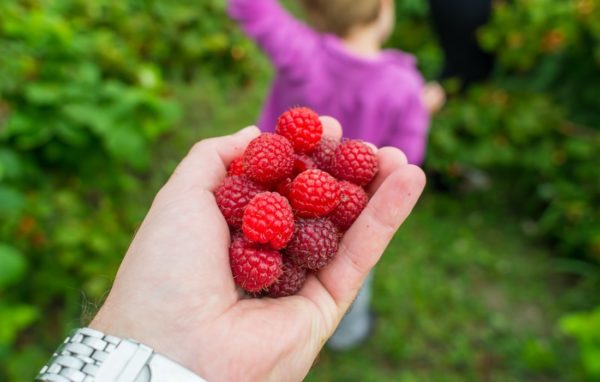
Repair raspberries - This is a variety that is specifically bred to increase the fruiting period. Berries on the repairing varieties ripen on both annual and biennial processes.
The optimal time for planting in open ground of this kind occurs in the autumn months. Already next June you will be able to take the first crop, and the second time you can collect the fruits in September. Repairing raspberries after planting in the soil produces shoots, some of which grow and bear fruit for one year, and the other two seasons in a row.
Repairing varieties in the autumn bear fruit, giving a smaller berry yield than in June-July. Summer residents plant this type of raspberry on additional sites in order to have fresh and juicy fruits on their table in September.
Site selection
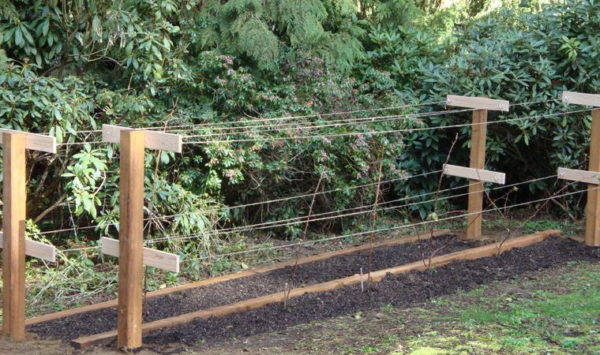
Planting remont raspberries in the fall begins with the selection of a suitable site, which is planned to be planted with seedlings. The plot must meet the following characteristics:
- to be sufficiently lit;
- without drafts;
- no excessive moisture;
- with loamy type of soil;
- with a high level of soil fertility.
It is necessary to plant repair raspberries in the ground with an acidity index of 5.8 to 6.8. The culture is actively growing and bearing fruit in neutral soils. The required amount of lime to reduce acidity should be calculated from the table.
| Soil characteristics | With acidity up to 4, g / sq. m | With an acidity of from 4.1 to 5, 0, g / sq. m | With an acidity of 5.1, g / sq. m |
| Peaty | 400 | 250 | 100 |
| Sandy | 500 | 300 | 150 |
| Clayey | 800 | 600 | 300 |
| Sandy loam | 1000 | 700 | 500 |
| Loam | 1400 | 1200 | 1100 |
You can also plant raspberry bushes in sandy and sandy soil, in which additional organic and mineral fertilizers are required
Soil preparation
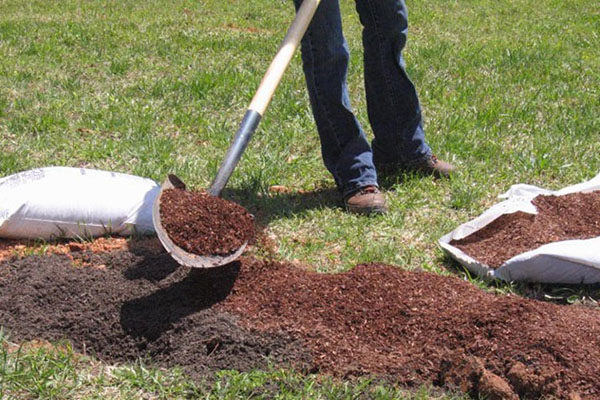
Autumn planting of raspberry of repairing varieties should be accompanied by preliminary preparation of the territory. Acidic soil must be liming. For these purposes, dolomite flour or limestone is suitable. The procedure should be carried out in the spring, after the snow melts. Before planting seedlings, it is necessary to re-analyze the soil for acidity.
Long preparation of soil
The time for preparatory work should be chosen 2-3 months before planting raspberries. It is necessary to follow the algorithm for preparing land for raspberries:
- Uprooting shrubs and trees on the site for seedlings.
- Digging with weed removal.
- The introduction of components, if necessary, to reduce acidity.
- Re-digging the earth.
- Harrowing.
- Sowing siderates.
Sidereal crops are natural helpers in creating an enabling environment for planting remont raspberries in the fall. By the time of planting, the land will be rich in the necessary set of nutrients and elements, so that the bushes quickly take root and have time to prepare for wintering. Mustard, lupine or rye get along well with raspberries and do not interfere with its full growth. Seeds should be sown in July, and in the fall on the territory under the seedlings it will be enough only to make recesses under the bushes.
Reduced soil preparation
In order to plant remont raspberries this season, and there is no time for planting green manure crops and preparing the soil in advance, the territory can be cultivated by the introduction of complex top dressing:
- remove all plantings and weed from the site;
- dig the soil to a depth of 20-30 cm;
- make a complex of fertilizers and mineral fertilizing;
- make a second digging;
- loosen the earth with a rake.
For each square meter of area under the raspberry, make a mixture of the following components.
| Name | Volume l |
| Overripe manure or humus | 20 |
| Peat | 20 |
| Phosphoric fertilizer (superphosphate) | 0,2 |
| Potash fertilizer (wood ash, potassium salt) | 0,2 |
Another option is to purchase ready-made complex fertilizers for berry crops in specialized stores. Thus, it is possible to enrich the soil with a set of useful substances and trace elements necessary for raspberries. The root system of seedlings, placed in fertilized soil, quickly adapts to new conditions and the plant is better prepared for wintering.
Fertilizing during the vegetative period
For the active growth of shoots and the formation of ovaries, raspberry of repairing varieties needs periodic feeding. Bushes planted in autumn in May should be fertilized with organic and mineral fertilizers. Before applying nutrients, you need to remove weed grass around the bushes and loosen the soil a little.
| Fertilizer application period | Top-dressing composition | Cooking method | Consumption |
| May |
Sodium humate - 30 g or 2 tbsp. l Water - 10 L or Cow Dung - 500 g Water - 10 L |
Dissolution in water | Watering at least 1 liter for each bush |
| May June |
Wood Ash - 200 g Water - 10 L or Potassium salt - 3 g Superphosphate - 3 g Nitrogen fertilizer -2 g Mullein - 1400 g Water - 10 L |
Dissolution in water | Watering 1 liter under each bush |
| July |
Superphosphate - 200 g Wood Ash - 200 g Urea - 60-80 g Water - 10 L |
Mixing components | Spilling a solution of furrows |
| September |
Chicken droppings - 1000 g Water - 30 L |
Stirring with water | Watering under each bush 2 l |
At the time of harvest, raspberries do not need to be fed. The last feeding should be done at the end of the summer season. Experienced gardeners after raspberry pruning and mulching adds rotted cow dung or chicken droppings around the bushes.
Layout of planting material
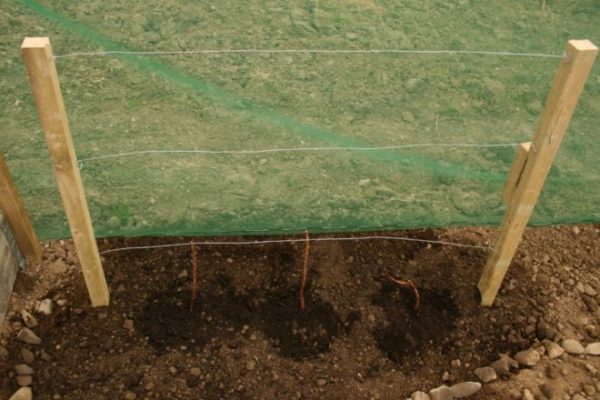
To place bushes of repair raspberries is necessary in compliance with the distance between plantings. Seedlings should be placed at a distance from each other so that the plants receive enough solar heat, moisture, nutrients, as well as for the convenience of caring for them. You can practice the following layout patterns of planting material:
- tape
- square bush;
- curtain;
- triangular.
A number of planting methods can save space, some methods encourage the culture to bear fruit more actively.
Tape method
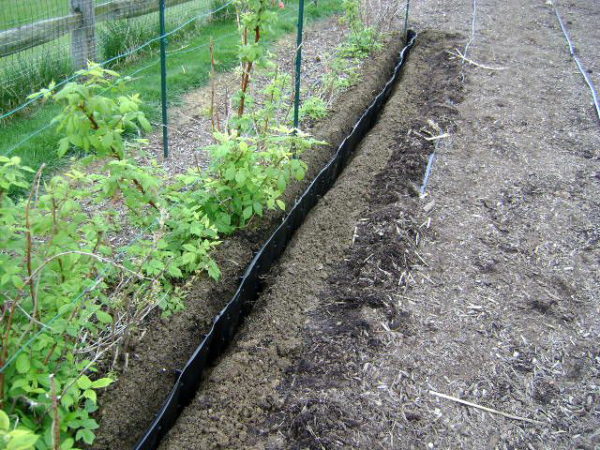
The raspberry planting pattern resembles even rows, the distance between which is at least 100-150 cm with plants in each ribbon with an interval of at least 70 cm. The method is characterized by the following advantages:
- it is convenient to tie bushes on a trellis frame;
- it is possible to make rows of any length;
- neat view of the site;
- easy to harvest;
- it is possible to pruning plants, weeding, fertilizing, treatment from pests and diseases, sowing green manure without difficulty.
If you plant raspberries of a low-growing repairing variety with a small number of shoots, the distance between the bushes can be reduced to 50 cm.
Square Bush method
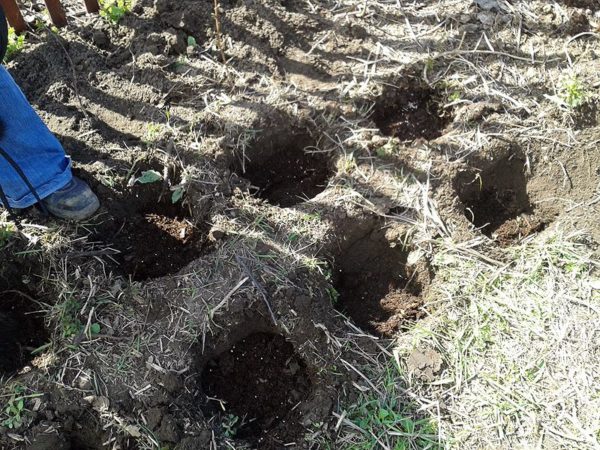
For large areas under the raspberry, you can plant the material according to the square-bush scheme. When using this method, plants are planted in holes that are located at an equal distance from each other. The distance between the seedlings should be from 70 to 100 cm. At the same time, you have the opportunity to process the shrub on each side, weed the aisles, and transplant. Subject to the recommended distance during planting, the raspberry will regularly bear fruit and expand.
Curt method
When planting weakened seedlings or plants with a small number of shoots, you can use the curtain system, in which 3-4 units of planting material are placed in one hole. In this case, the root system of each plant should be carefully straightened. Between plantings, a distance of at least 70 cm is required. You can arrange bushes in rows or plant in a square.
Triangular pattern
For connoisseurs of aesthetics at the site, planting raspberry bushes of repair varieties can be done in the form of a triangle. In this case, each side of the figure should be the same length. Seedlings need to be placed at a distance of 50 cm from each other. If you choose different varieties of repair raspberries, you can get a shrub with bunches of ripe berries of different colors.
Dates for boarding
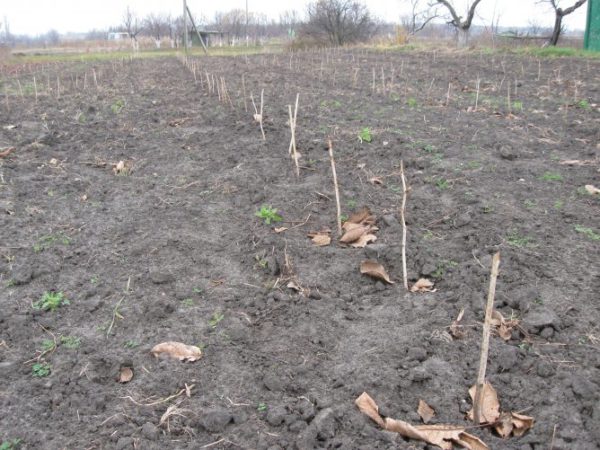
It is important to choose the right time when it will be right to plant raspberries of repair varieties. Landing should be done no less than a month before the onset of constant frost. Depending on the region of residence, autumn raspberry planting dates vary from mid-October to early December.
In the European North, Siberia and the Urals, it is advisable to plant seedlings at the end of September. For central Russia, October is the optimal time for planting raspberries. In the southern regions, berry bushes can be planted in November. You need not to be late with the timely planting of raspberries, otherwise it will be more difficult for the seedlings to adapt to frost. Early planting is also undesirable, as plant resources will be spent on growth. New shoots may die during the winter.
Raspberry picker
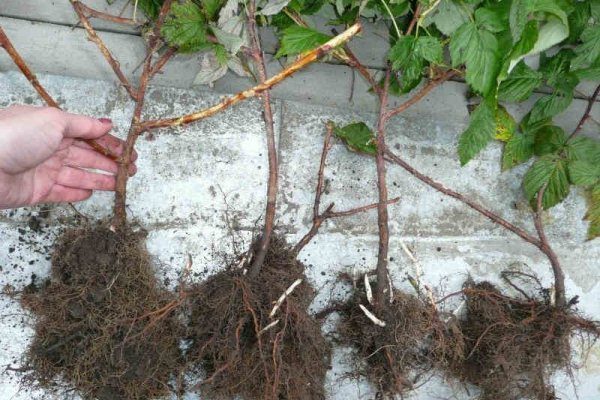
Raspberry planting in the autumn months possible varieties of different ripeness. You can prepare seedlings that produce crops sooner and later. Thus, it is simple and easy to provide your family with fresh juicy berries until late autumn.
Experienced summer residents highly appreciate the following varieties for productivity and fruiting:
- Golden domes;
- Indian summer;
- Ruby necklace;
- Golden autumn;
- Polana et al.
Seedlings must be purchased at large farms or from trusted sellers. Before buying bushes, you should examine each plant and its root system.
Seedling preparation
You can plant both purchased annuals and cuttings on the prepared site. They adapt best to winter and tolerate cold plants with stems with a diameter of about 55 mm near the root system and a height of not more than 20 cm.
Do not choose bushes with damaged roots. Long roots before planting must be cut with a special garden tool.For planting, you should prepare a special solution in which you need to immerse the root system before deepening into the prepared hole.
In equal parts, take clay, cow dung and water. Mix all components in a large container until thick sour cream. Dip the root system of each seedling before planting in the prepared solution. The solution is evenly distributed along the roots and will create a favorable environment for the adaptation of the plant to new conditions.
How to plant repair raspberries
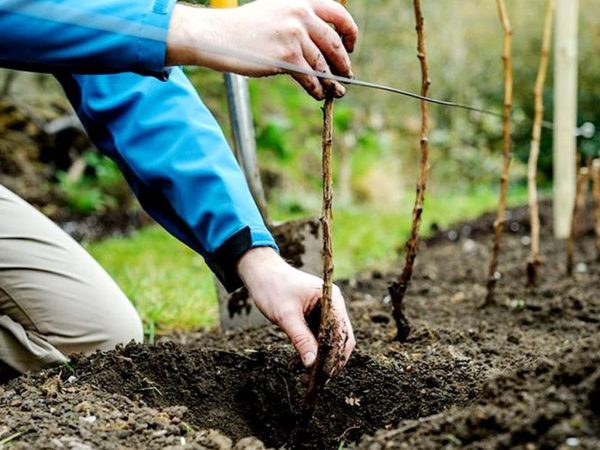
Experienced gardeners apply several different planting methods for remont raspberries. You should choose how the method will be more convenient for you, so that it is easy to care for the planted bushes and harvest.
Seedlings can be planted:
- into the furrows;
- into the pits;
- bushes;
- in the trench;
- in the tank.
The choice of planting strategy depends on the size of the site on which the raspberry is planned to be broken. Each of the methods is characterized by its advantages and disadvantages.
Furrow or ordinary way
For the prompt planting of remont raspberries, you can use the planting of seedlings in the grooves with a depth of 0.4 m. To put compost, potassium and phosphorus fertilizing on the bottom of the prepared rows, sprinkle with soil. Seedlings should be placed at a distance of 0.7 m from each other with a spread root system. Sprinkle the bushes with earth, pour over and lay a layer of mulch on top. The distance between the furrows must be observed, it must be at least 1.5 m.
Landing in the pits
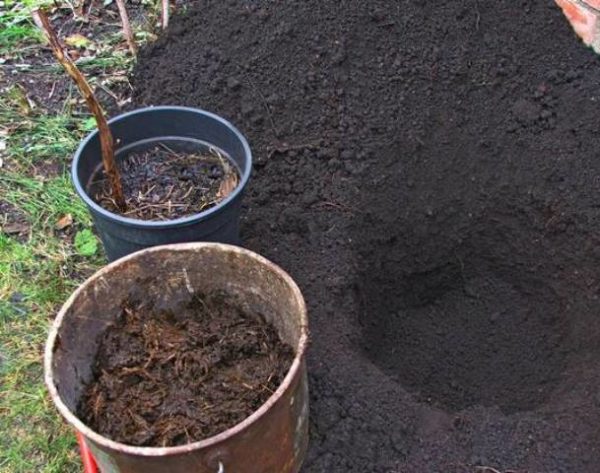
Planting Raspberry Bushes into the pits the most popular way for summer residents in all Russian regions, which requires a minimum of effort. For the pit method, you need to dig indentations with a depth of at least 0.4 m and a diameter of at least 0.5 m. It is important to keep at least 1.5 m between the rows with pits.
The distance between the pits should be at least 0.7 m. This will allow the bushes to fully develop and bear fruit, not competing for sunlight, moisture and nutrients. Each seedling should be immersed with a straightened root system to the bottom and sprinkled with earth the remaining space. After planting, the bushes need to be watered and laid on the soil surface around each seedling a layer of mulch with a height of at least 10 cm. The patching method is suitable for areas with high soil fertility.
Bush method
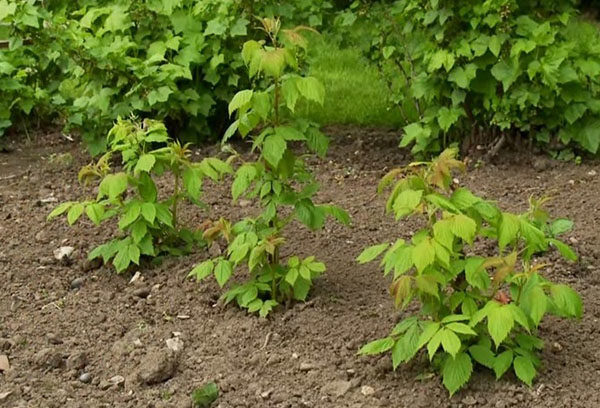
Gardeners also practice planting raspberry seedlings of repairing varieties using the bush method. To do this, in the area under the raspberry, you need to prepare large pits for planting several seedlings. You must observe a distance between rows of at least 1.5 m and at least 1.2 m between adjacent bushes.
Depending on the soil fertility, organic fertilizer and mineral top dressing should be poured into the dug hole. Place seedlings with a spread root system on the prepared pillow. Trim weak and small shoots. Sprinkle the resulting bushes with 8-10 stems with earth to the basal bud, water and mulch. After 3 seasons, raspberry bushes grow into comfortable plantings that are easy to care for and harvest.
Trench landing method
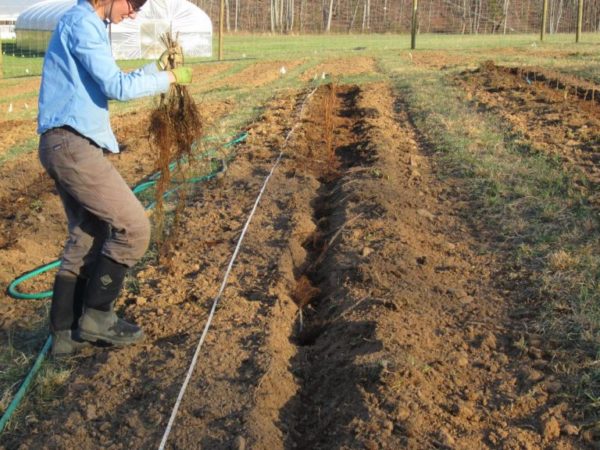
The method of planting raspberries in trenches can be used when it is planned to break raspberries for a period of at least 10 years. The method consists in digging grooves for seedlings into which complex fertilizers must be applied. Gardeners mark the trench landing as the most productive. Preparing for landing with this method should begin in 2-3 weeks.
To make trenches for raspberry seedlings of repairing varieties, you can apply the following step-by-step instructions:
- make markings on the site of the planned trenches with the help of a rope and pegs;
- dig trenches up to 5 m long, 0.6 m wide and at least 0.5 m deep;
- add rotted mullein, humus or compost to the bottom of the dug ditches;
- sprinkle phosphorus and potassium fertilizer on top;
- cover the mixture with ordinary soil at least 5 cm high;
- dig a pillow prepared under the bushes;
- place seedlings on top of the fertilized bottom surface, gently straightening the root system;
- make backfill with soil until the neck is located at the rhizome;
- compact the soil slightly;
- water the planted plants;
- cover the area around each bush with straw, hay or sawdust.
If a lot of space remains in the trench, it should be completely filled with mulch. The natural filler will serve not only as a drainage, but also in the process of decay, it will generate heat, protect seedlings from freezing, and nourish plants with necessary substances.
Tank fit
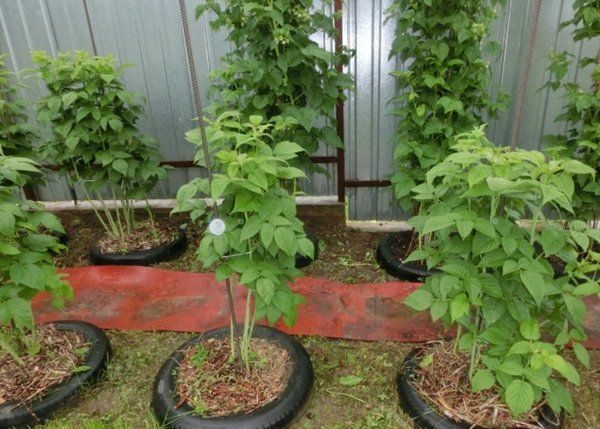
The method of planting raspberry of repairing varieties in a container will significantly save space in a limited area. You can plant bushes in empty barrels, boxes or buckets. For prepared containers, it is required to remove the bottom in order to ensure drainage and the possibility of developing the root system in the soil of the site. You do not need to dig beds under the raspberry and violate the landscape.
To plant raspberries in a container, fill each tank with fertilized soil by 2/3, make a depression under the seedling and plant a bush. Fill the remaining space with earth and lightly tamp the landing. For the capacitive method, any containers with a diameter of at least 50 cm and a height of at least 30 cm are suitable.
Breeding methods
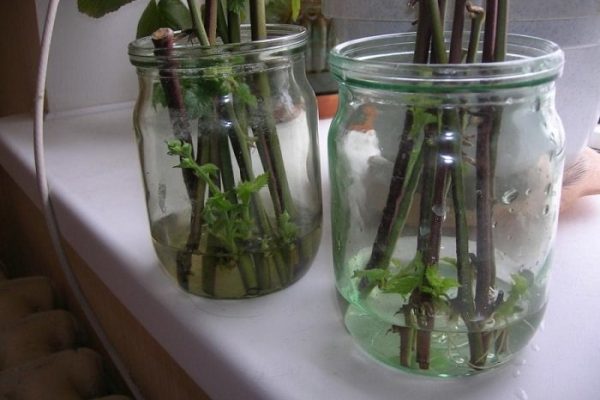
Repair raspberries can be propagated in various ways. Saplings take root well on various types of soils and are unpretentious in leaving. You can buy only 2-3 bushes and break a full raspberry by gradual propagation of varieties.
Among gardeners with experience, such methods as reproduction have proven themselves:
- offspring;
- rhizome cuttings;
- division of the bush;
- green cuttings.
You need to inspect your seedlings and choose in what way it will be more successful to plant the culture on the territory.
Propagation by offspring
To propagate raspberry with the help of offspring, it is necessary to choose annual plants that already have stiffened stems and grow at least 30 cm away from the bush. Next, you should dig a bush in September with sufficient capture of soil under the root system and transfer the seedling for transplantation to the selected place.
Propagation by cuttings of rhizomes
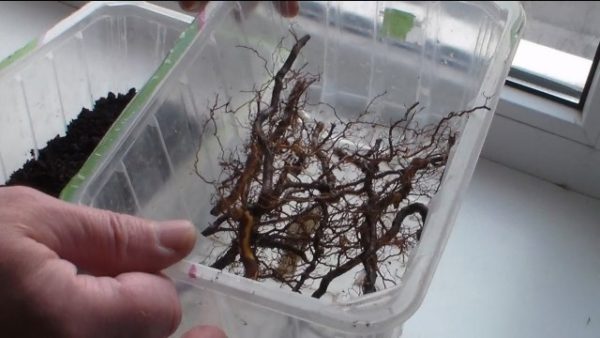
For the method of propagation of raspberry of repairing varieties using root cuttings, spring or late autumn is suitable. It is necessary to dig out the soil on one side of the main bush at a distance of 40 cm and cut off part of the root system with the kidneys. Next, you need to loosen the soil and free the rhizome. The next step is to make segments of 10 cm from the main root so as to preserve all the additional roots and buds. At the end, plant the root cuttings in the prepared soil.
Reproduction by dividing the bush
If the main raspberry bush is growing rapidly, it can be divided. To do this, dig the earth in the part that you are going to plant, and cut off the root part while maintaining the additional roots. It is important to ensure that each bush has 2-3 shoots.
Propagation by green cuttings
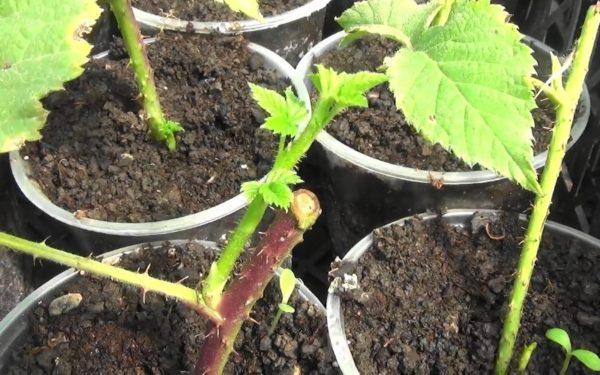
To increase the area of raspberry with propagation by green cuttings, suitable spring after the snow has melted. For the method, you need to select green shoots up to 20 cm high, grown at a distance of at least 40 cm from the main bush. Next, you need to dig a plant with the capture of the earth and then plant the bush in a new place.
Trellis arrangement
For the second season, raspberry of repairing varieties becomes a tall plant and requires the installation of structures that will ensure the stability of the bushes from the wind, heavy rain, and the elimination of the death of branches due to a rich harvest. The bush supports are called trellis.
It is better to think about organizing a trellis frame even at the stage of planting seedlings.For its construction, it is necessary to install, during the planting, post-columns with a height of at least 2 m at a distance of 1.5 m. Then, the cross-beams should be screwed onto the supports in the form of strong non-thick poles or wires at a height of 30, 100 and 150 cm. During raspberry growth, you can timely garter branches at different heights.
Mulching
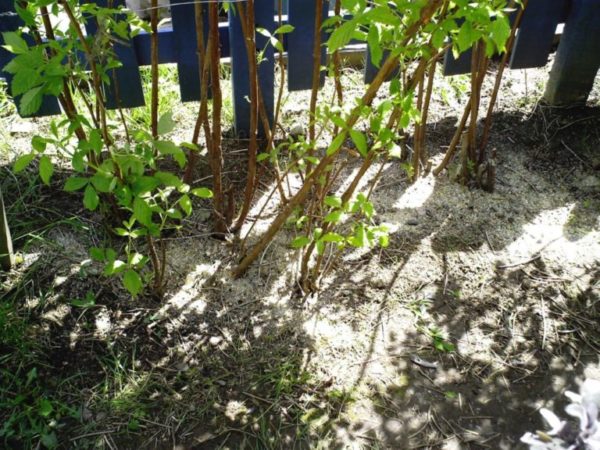
Laying a layer of mulch around planted raspberry bush bushes is a necessary measure that will not only protect the root system from the cold, but also during the process of over-heating will serve as a source of nutrients. Mulching also allows you to create natural drainage during prolonged rains and serves as an obstacle to root damage by fungal diseases.
You can use as a layer of mulch:
- weeds
- tops;
- cut hay;
- old straw;
- fallen foliage;
- sawdust.
Mulching will save you from organic waste in the garden. You no longer need to think about where to remove leaves, grass, tops. This is a great way to fertilize plants and keep the plot in order.
Caring for a young raspberry
For raspberries to fully grow and regularly bear fruit, regular care should be carried out, which includes:
- watering. The event must be timely to prevent drying out of the soil. The best way is drip irrigation. It will always maintain the desired level of soil moisture, and will not allow waterlogging. Excess moisture is a favorable environment for the multiplication of fungus and other diseases;
- top dressing. Throughout the summer season, raspberries should be fertilized with mineral organic fertilizers. It is important to remember that nitrogen-containing compounds should be applied with caution. The appearance of plants can signal a deficiency or deficiency of certain elements in the soil;
- weeding. Wild weed grass or other shrubs should not grow around raspberry bushes. At least 1 time per month should weed the raspberry bush;
- tying up. Shoots must be tied up at different periods, depending on the height of the bush. Using the trellis frame and three levels of crossbars, you can fix young offspring, tall shoots, heavy branches with berries to protect them from strong winds, heavy snow or heavy rain;
- treatment for diseases and parasites. It is necessary to monitor the condition of the bushes, timely work on pest and fungal diseases. Regular treatment with fungicides based on natural components will protect raspberries from most known pathologies, strengthen the plant, stimulate its growth;
- pruning. After harvesting, it is necessary to prepare the culture for the winter period. To do this, use a secateurs to remove dead branches and shoots that you do not need;
- shelter for the winter. With the onset of cold weather take care of the root system and young shoots of berry bushes. If you cover the raspberry with special covering material, straw or hay, you will prevent freezing and death of the crop.
Raspberry Care - an integral part at all stages of cultivation. In order to get a rich harvest and active plant growth, a number of measures should be taken periodically to maintain the crop in order.
Sowing of green manure
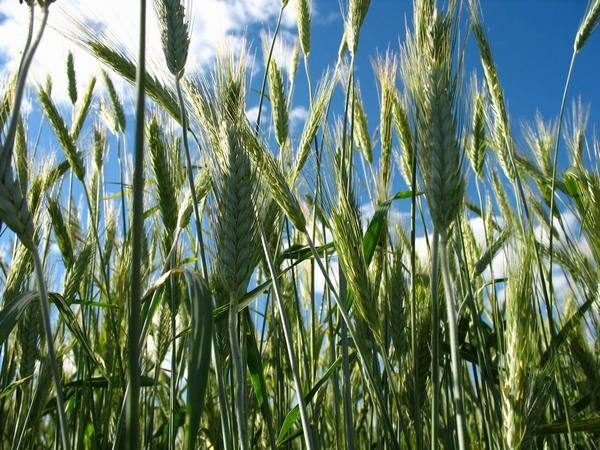
If you did not carry out preparatory work in the territory with planting green manure, then after planting remont raspberries you can do it. Siderata well maintains snow cover, which will protect the raspberry root system from freezing.
As siderates for raspberries, they have proven themselves well:
- oats;
- mustard;
- rye;
- wheat.
For sowing, you need to make grooves between the rows of raspberries with a width of 10 cm and a depth of 1-2 cm, then scatter grains, sprinkle with soil. Sown seeds will germinate after 14 days.
Conclusion
Planting remontant raspberries in the fall will provide you with fresh berries already in the middle of next summer.The correct selection of varieties will enable regular harvesting of our own environmentally friendly raspberries. It is necessary to seriously approach the selection of a plot for raspberry trees and comply with all recommendations for planting seedlings. Regular care in the form of pruning, nutritious dressing and timely watering will be the key to stable fruiting for many seasons.

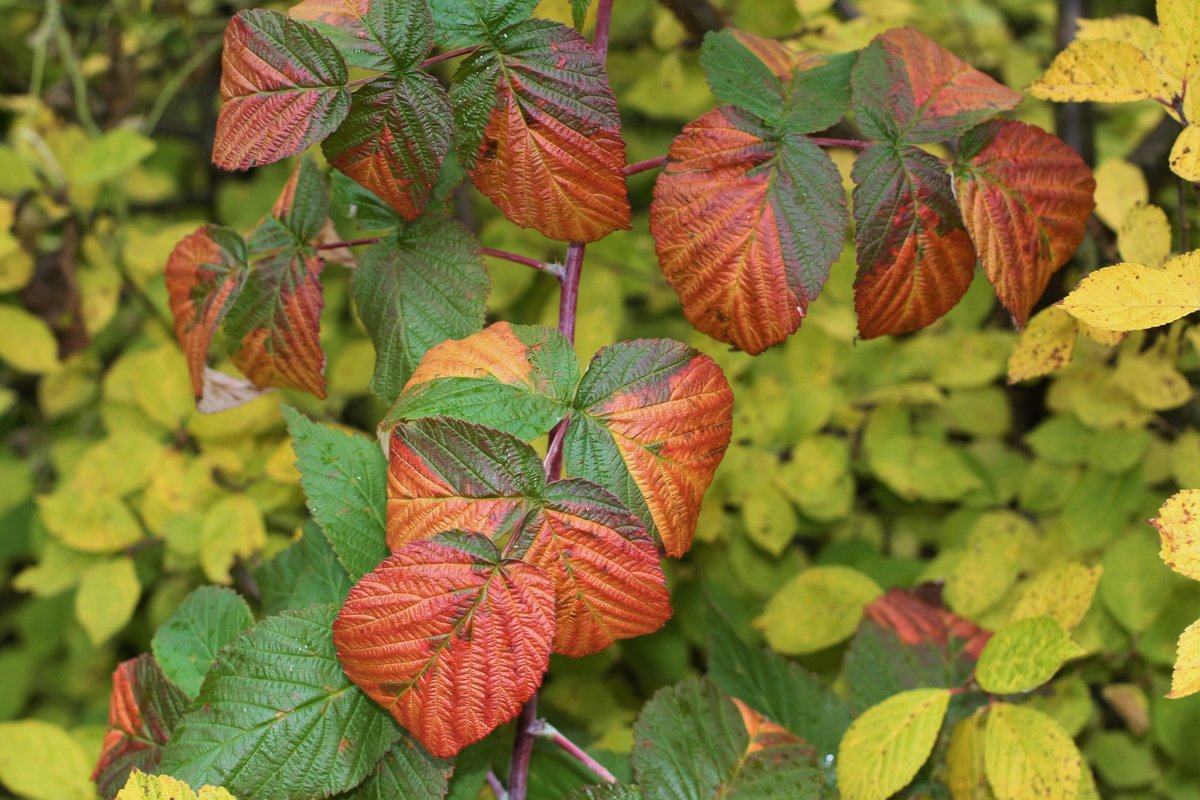 Black raspberries in autumn: care and preparation for winter shelter, pruning
Black raspberries in autumn: care and preparation for winter shelter, pruning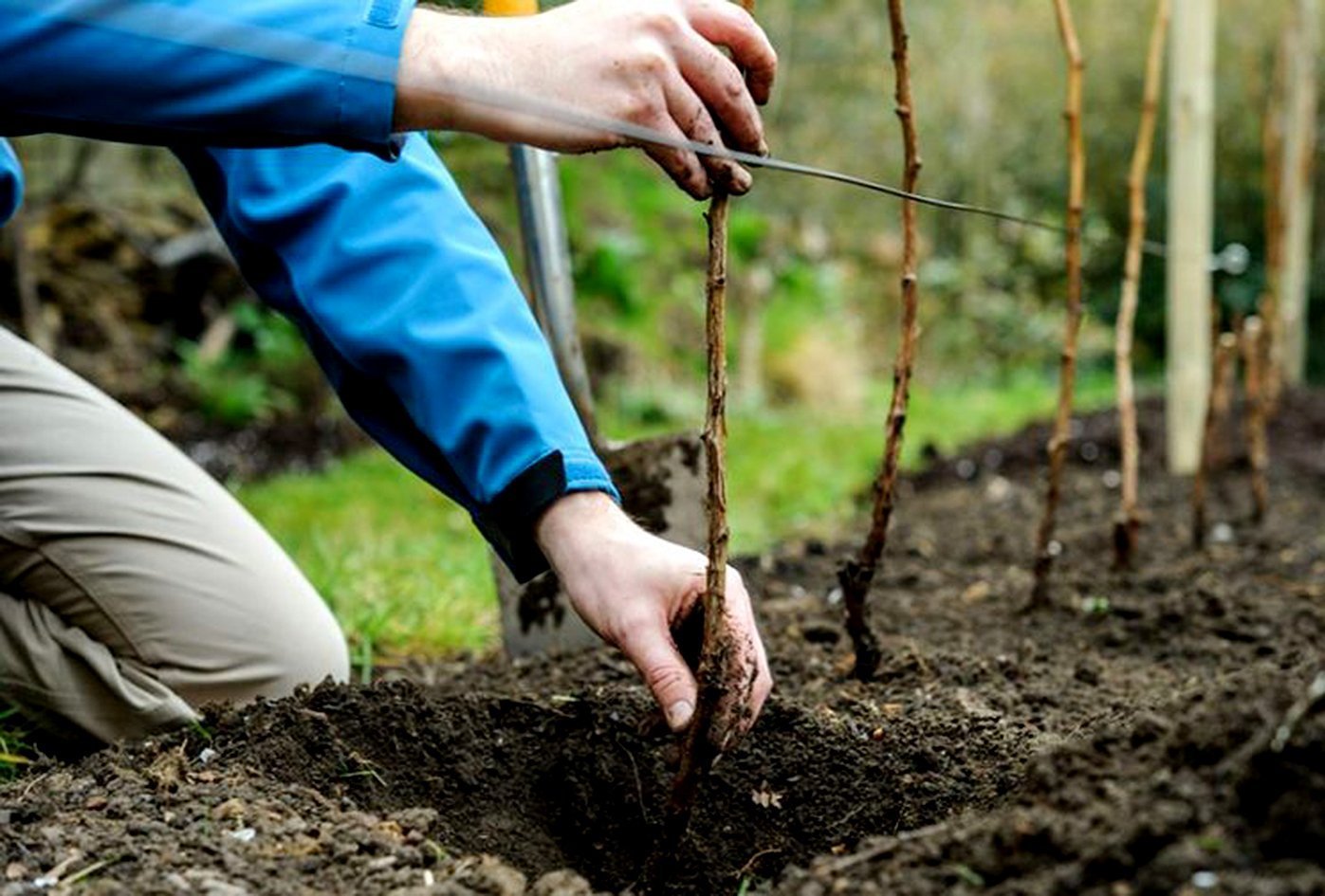 Features planting raspberries in the fall and care for it
Features planting raspberries in the fall and care for it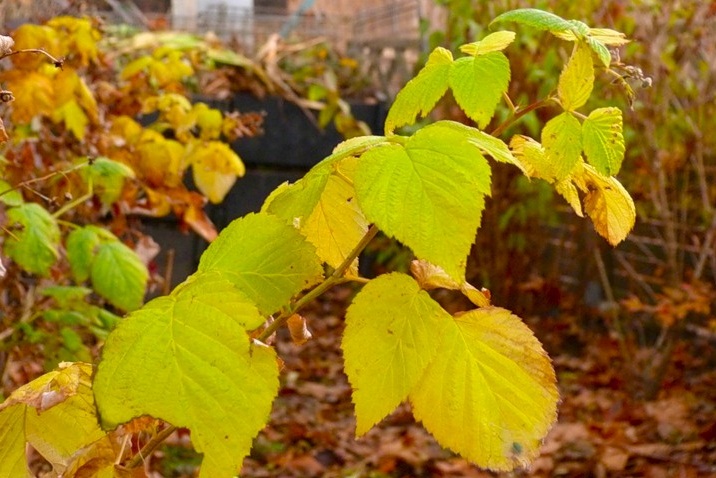 Proper care for raspberries in the fall and its preparation for winter
Proper care for raspberries in the fall and its preparation for winter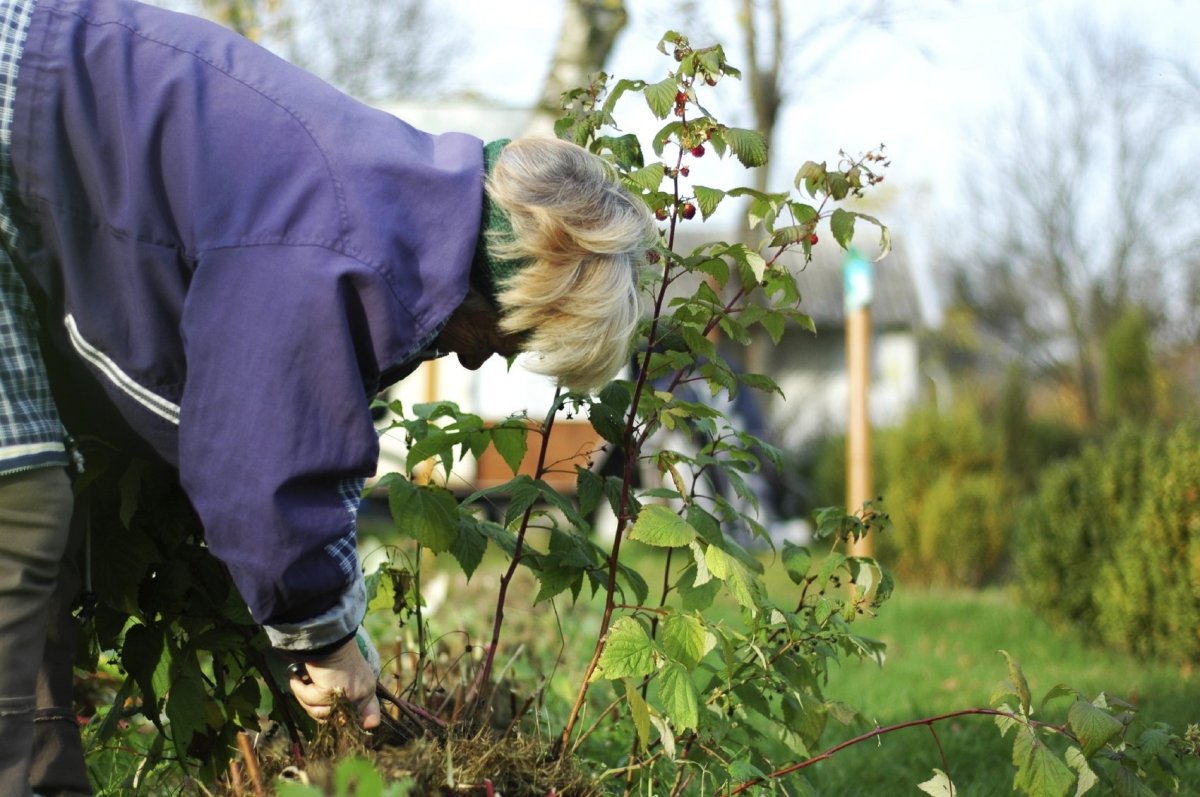 Care for maintenance raspberries in autumn: pruning and top dressing
Care for maintenance raspberries in autumn: pruning and top dressing